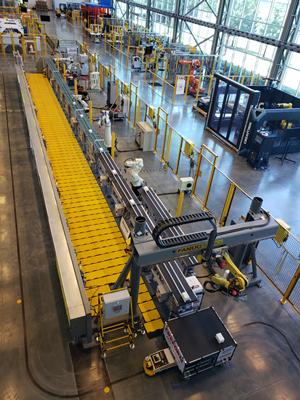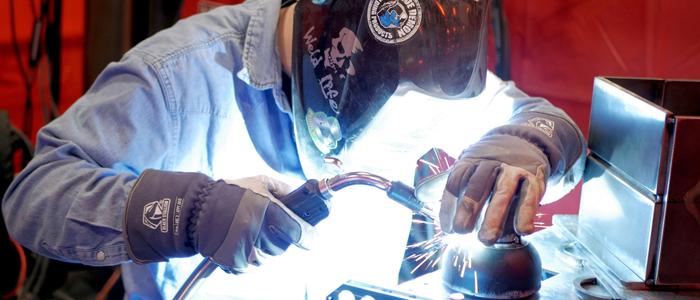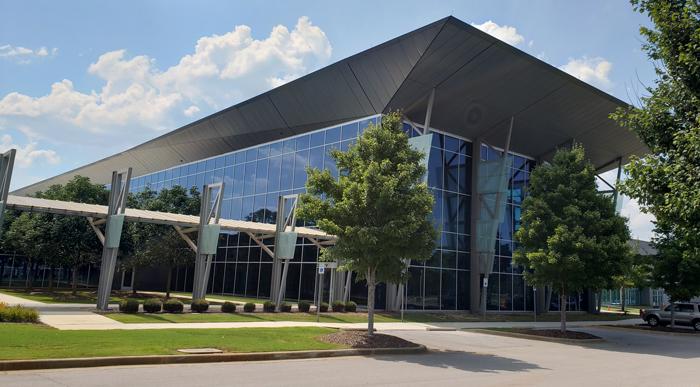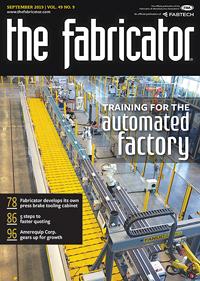Senior Editor
- FMA
- The Fabricator
- FABTECH
- Canadian Metalworking
Categories
- Additive Manufacturing
- Aluminum Welding
- Arc Welding
- Assembly and Joining
- Automation and Robotics
- Bending and Forming
- Consumables
- Cutting and Weld Prep
- Electric Vehicles
- En Español
- Finishing
- Hydroforming
- Laser Cutting
- Laser Welding
- Machining
- Manufacturing Software
- Materials Handling
- Metals/Materials
- Oxyfuel Cutting
- Plasma Cutting
- Power Tools
- Punching and Other Holemaking
- Roll Forming
- Safety
- Sawing
- Shearing
- Shop Management
- Testing and Measuring
- Tube and Pipe Fabrication
- Tube and Pipe Production
- Waterjet Cutting
Industry Directory
Webcasts
Podcasts
FAB 40
Advertise
Subscribe
Account Login
Search
One state’s solution to the skilled labor crisis
How a robotics training center boosts modern manufacturing, economic development
- By Tim Heston
- August 28, 2019
- Article
- Additive Manufacturing
More than a decade ago a CEO stepped on a stage in Cullman, Ala., between Huntsville and Birmingham, ready to speak about a plant expansion with then Gov. Bob Riley in attendance. The CEO walked to the podium. Before he began, though, an assistant sprang up and whispered in his ear. A manufacturing line had just crashed and the robots were offline.
The CEO announced he had to go. Riley quickly asked, “Why don’t you have your maintenance person fix it?” The CEO said he would, but the company didn’t have one at the moment; the robot maintenance tech had just quit. Riley asked if the company had a backup person. “I would,” said the CEO, “but we don’t have one. You promised that when we [the company] came here, we’d have a trained, qualified workforce. But we’re having to go up north to hire these people. That’s an issue for us.”
That incident, as told by Nancey Green Leigh and Benjamin Kraft of Georgia Tech in the summer 2017 edition of Economic Development Journal, eventually led to the opening of the Alabama Robotics Technology Park (RTP). Known to those who work and train there as “the park,” RTP is a massive, gleaming training campus that opened in Tanner, Ala., west of Huntsville, in 2010.
On the surface, it’s an impressive training facility with dozens of robot brands and technologies, many of them bleeding-edge, including a wide range of robotic welding cells. But underneath the shiny facade, the park represents a unique approach that tackles challenges in two inextricably intertwined areas: economic development and skilled labor. In most of modern manufacturing, it’s impossible to have one without the other.
Unique Training
The park’s towering atrium could be the grand entrance to the headquarters campus of a global corporation. In one corner sits a small collaborative robot with integrated vision, with a small arm continuously arranging and rearranging round chips. Reach in and move a chip to another location, and the robot knows something’s up and changes course.
Opposite the atrium entrance is a roomful of flat screens showing the latest in robot uptime tracking and predictive maintenance—the potential of Industry 4.0, where machines and the cloud meet. Climb the adjacent stairs and you’d see RTP’s most impressive spectacle, a glass-enclosed high-bay floor full of automation of various types and brands.
On one side is a row of robotic cells and other machinery, everything from plasma cutting and stud welding to a laser-based robotic system that automates various inspection tasks. On the other side is a comprehensive assembly cell involving numerous robot and control brands, along with an automatic guided vehicle parked by a robot that feeds the line. Near that is a unique welding robot cell on a table, a training setup for a robot that welds on two assembly lines, one on top of the other.
Much of the place looks like a community or technical college welding instructor’s dream teaching laboratory, but then the instructor would see that dual-level welding robot designed to feed two assembly lines. Far too specialized for a general welding or industrial training program, the robot reveals that RTP isn’t a technical school at all, but an entirely different animal.
The park is designed to work with Alabama companies, their full-time employees who need training, and the vendors who supply the manufacturing technology. It’s a collaborative effort that helped thousands of Alabamians receive training. Last year alone RTP trained more than 1,700 people. Funded by Alabama taxpayers, RTP never charges Alabama companies for its services.
A typical class at RTP, usually limited to about 10 students—mainly because of the amount of hands-on training involved—forms to serve a training need. Companies sign up their employees; employees can’t sign up themselves.

The tip of a welding robot gun sits idle on the park’s high-bay floor. A material handling robot sits in an adjacent cell.
The park does offer generalized training too, including OSHA safety classes, which can have larger class sizes. It also offers fork truck training, using a fork truck simulator complete with virtual images both ahead and behind the steering wheel.
Employees typically travel to the RTP campus for a weeklong class that’s taught by an RTP employee who has industrial experience and has been trained by experts at an automation vendor—a typical “train the trainer” approach. For robotic welding, the center works with and tests to American Welding Society standards like AWS D16.4, the standard for qualifying robotic arc welding personnel.
At the end of the week, if they pass the required tests, the employees receive a certification from the vendor proving they know how to operate and/or maintain a specific piece of equipment. If they don’t pass, they aren’t certified, and the employer can decide what steps to take next.
Being state-funded, RTP is designed to serve people who work in plants located in Alabama. If an Alabama company also has a plant in, say, Georgia, employees in Georgia aren’t eligible for training at the park.
The same applies to manufacturing technology. RTP isn’t a sales showroom. The training center has an impressive range of technology, but if it’s not used somewhere in Alabama by a company’s permanent full-time employees (not part time, contract, or temporary), then you won’t find it on RTP’s three-building campus. That said, the park is open to Alabama companies of any size, from the largest automotive players to the smallest job shops.
Operating under Alabama’s Department of Commerce, RTP is part of what used to be known as the Alabama Industrial Development Training. Today it’s known just as AIDT, since the agency now offers many services outside the industrial arena. AIDT has almost a dozen locations across the state, all designed to support Alabama employers. For instance, an AIDT center near the southern tip of the state offers free (or technically, state-taxpayer-funded) welding classes to support the shipyards.
Each AIDT facility serves a unique function. “We never duplicate our services [at different AIDT locations],” said Kristi Bain, assistant director of North Alabama at AIDT, who manages RTP operations. “We need to be good stewards of taxpayer dollars.”
A new AIDT facility also is slated to open adjacent to (and dedicated to) the new Mazda Toyota plant in Huntsville. In fact, a large robot from RTP manipulated a silver shovel during the groundbreaking ceremony in 2018—an obvious nod to the benefits of Alabama’s training infrastructure.
“Whenever incentives are given to companies that come to the state, if those companies are hiring full-time employees here, we [RTP and AIDT] are part of that incentive package,” Bain said. “We run marketing efforts, we set up online ads, we screen their applicants, and we will put them through assessments. We’ll also perform drug testing. And then the companies decide which applicants they want to hire. After that, we make sure that is where the park comes into play.”
Although RTP was built for Alabama companies, it doesn’t close itself off to those outside the state. In recent years economic developers from other states have visited the park to glean insight into how the program runs. As Bain explained, representatives from other states particularly want to know about partnerships RTP forms with automation vendors.

The high bay at Alabama Robotics Technology Park houses a range of robot and automation brands and capabilities, from welding to advanced assembly.
Although the park does receive taxpayer money, it still has limited funds, so it can’t afford to buy every robot or other advanced automation system under the sun. Sometimes the park offers in-kind arrangements in exchange for equipment. This can involve anything from providing meeting spaces to training services.
Bain emphasized that the nature of these partnerships hinges on specific circumstances, including a vendor’s presence at Alabama manufacturers and the training needs companies have. That said, those partnerships—touted on RTP’s website and throughout the campus—help make the park what it is.
Helping those partnerships work is a host of nondisclosure agreements. As Bain explained, “We don’t promote who’s in the park, and we don’t let people know who’s here training and what they’re training on. Everything here is protected, and it’s one of the reasons vendors can come in here and work so well together.” (RTP does list current partners on its website, so Alabama companies and taxpayers have an idea of what brands the training center offers, but the details behind those partnerships aren’t published.)
The park works with vendors to set up designated training areas. Some vendors choose to place equipment in the high-bay area, the welding lab, and other public spaces, while others choose to place equipment in classrooms closed off from general traffic.
Such competitive protections extend to Alabama manufacturers that send employees to the park for training. Pictures are permitted of RTP facilities, trainers, and administrators, but not of the people being trained, save for the back of their heads as they sit in a classroom.
The Training Challenge for Automation
Welding schools and technical colleges produce entry-level talent, but they’re just that—entry-level. Training shouldn’t stop with a certificate or associate degree. As Ryan Blythe, director of the Georgia Trade School, a private technical school outside of Atlanta, said in a 2014 interview, “I’ve backed away from employers who aren’t willing to train. No matter how many certifications a new welder may have, he’s not going to be the perfect welder on day one.”
On-the-job training has become even more important and more challenging as manufacturing has become more automated. Sure, technical schools can’t afford the advanced automated equipment that RTP has on its floor, but in many cases, it wouldn’t matter if they could.
In their journal paper, Leigh and Kraft describe robotics and industrial automation in general as “a highly proprietary field.” Manufacturers work closely with automation suppliers on setups unique to a company or plant—an “automation recipe,” so to speak. The ingredients are common, with teach pendant programming, simulation packages, programmable logic controllers (PLCs), and the like. But the recipe, how those ingredients go together, is often unique.
So even if community colleges and technical schools had all the funding in the world to purchase specialized automation systems, learning such a system wouldn’t give students the broad foundation they need for a successful career. And they probably wouldn’t be able to apply what they learned unless they happened to be hired by companies that use a specific automation setup or something similar.
But the people who are trained at the park already have a job, and their employer has already invested in the automation. Shutting down production for training gets more expensive as the automation becomes more productive. Mistakes are more expensive too, considering it doesn’t take a robotic line long to produce a lot of bad parts, and an operator or maintenance tech error can be incredibly expensive.
So Alabama companies send employees to the park, where they can learn the automation without interrupting production. Equipment at RTP won’t mirror the company’s automation line exactly, but it has enough of the basic components to make the training effective.
A Focus on Alabama’s Employers
At first glance the park looks like a place specializing only in advanced automation, providing training that would be too advanced for most students attending a community or technical school—but that’s not entirely accurate. Some training is advanced, some isn’t.
“The difference is, our students are employed, and we focus on the job at hand. The goal is to get people on par with their co-workers.”
That was Shane Snead, robotic welding instructor at the center. Snead’s welding lab offers courses not only in robotic welding but also various levels of manual welding, from the use of virtual welding simulators to basic bead-on-plate to advanced certifications required by AWS codes.
Some manual welding classes are tailored for those with a little welding experience but who also need to perfect their skills before operating a welding robot. Snead said that this supports a philosophy held by many Alabama manufacturers: In an ideal world, an effective operator of a welding robot should know a good deal about manual welding. At best, that person should be able to pick up a rod or welding gun and lay down a respectable weld by hand.
One weeklong class covers manual welding fundamentals, by the end of which students should know how to weld bead-on-plate. Another fundamental class covers the basics of joint designs, at the end of which students should know how to lay down acceptable fillets and lap joints. “We may run in the flat position, horizontal, even overhead,” Snead said. “It really just depends how far we get during those 32 hours.” (Classes run eight hours a day, Monday through Thursday.)
Snead emphasized that while a two-year technical school prepares a student for a career in welding or other industrial specialty, classes at RTP are tailored specifically to support Alabama manufacturers’ needs. For instance, many maintenance technicians might need to weld occasionally, and so they travel to RTP for a week to learn the fundamentals. At the other end of the spectrum, a company might need to train and certify advanced welders to a code; in these cases, RTP works with a certified welding inspector (CWI) to develop the class and conduct testing.
The park now takes a similar approach to powder coating. Like in welding, the best operator of powder coating robots knows the basics of powder gun operation. So it offers manual powder coating simulation along with robotic spray cells. The idea is to offer companies the ability to help their employees attain the full spectrum of powder coating skills, from basic manual operation to advanced automation.
Economic Growth and Wage Growth
According to Bain, program funding of AIDT and RTP in particular hasn’t waned, mainly because the effort has become a keystone to growth in so many areas of the state. “I think this has become such a help to Alabama industry, there’s really no question [regarding funding]. We support so many companies in the state, and all of our state legislators recognize the opportunities in their own districts.”
Since the first phase opened in 2010, the park campus added two more buildings. One houses research and development space that Alabama companies can lease for 18 months. The third building houses CNC machining centers, vision and software system training, as well as powder coating cells.

A welder competes in an invitational weld trials event as part of the WorldSkills competition, held at RTP in 2018. Photo courtesy of the American Welding Society.
In September the park will launch what it calls RTP 2.0, an initiative to support Alabama manufacturers’ future needs. It’s adopting metal additive manufacturing, remote systems monitoring, process simulation, uptime tracking, predictive maintenance, and much more, including technologies related to Industry 4.0.
Although the park serves Alabama employers’ specific needs, in certain ways it also works to promote the manufacturing trade overall. After all, manufacturers would have a tough time recruiting if Alabama schoolchildren and parents had no inkling about what really goes on in a manufacturing plant.
To this end, the park has a range of industry outreach efforts. For instance, last year RTP partnered with AWS and hosted a WorldSkills invitational weld trials event as well as a separate robotic welding skills competition. It also sends its Mobile Robotics Training Lab—an 18-wheeler full of technology like virtual welding booths and collaborative robots—to schools and other institutions around the state, offering a taste of what manufacturing automation has to offer.
Of course, taxpayers support the park, and the last thing these taxpayers want (along with the state representatives they elect) is to support an industry that aims to drive down wages. States want to see their citizens’ wages grow so they can spend more in their communities.
As Leigh and Kraft reported in their paper, average manufacturing wages in Alabama are indeed growing faster than the national average. Alabama wages jumped by more than 35 percent between 2005 and 2015, while overall U.S. manufacturing wage growth grew at less than 29 percent over the same time period.
Of course, Leigh and Kraft’s study isn’t all positive. As wages rose between 2005 and 2015, Alabama’s overall manufacturing employment dropped by more than 34,000—a stat that could point to the well-known double-edged sword of modern manufacturing. The industry automates and pays more but employs far fewer people than it once did.
Regardless, companies want to move and grow in areas with low costs of doing business, and this doesn’t necessarily mean lower wages. As evident by the crashed robotic line that helped launch Alabama’s RTP initiative more than a decade ago, opening a plant in an area without skilled people can be the costliest move of all.
About the Author

Tim Heston
2135 Point Blvd
Elgin, IL 60123
815-381-1314
Tim Heston, The Fabricator's senior editor, has covered the metal fabrication industry since 1998, starting his career at the American Welding Society's Welding Journal. Since then he has covered the full range of metal fabrication processes, from stamping, bending, and cutting to grinding and polishing. He joined The Fabricator's staff in October 2007.
subscribe now

The Fabricator is North America's leading magazine for the metal forming and fabricating industry. The magazine delivers the news, technical articles, and case histories that enable fabricators to do their jobs more efficiently. The Fabricator has served the industry since 1970.
start your free subscription- Stay connected from anywhere

Easily access valuable industry resources now with full access to the digital edition of The Fabricator.

Easily access valuable industry resources now with full access to the digital edition of The Welder.

Easily access valuable industry resources now with full access to the digital edition of The Tube and Pipe Journal.
- Podcasting
- Podcast:
- The Fabricator Podcast
- Published:
- 04/16/2024
- Running Time:
- 63:29
In this episode of The Fabricator Podcast, Caleb Chamberlain, co-founder and CEO of OSH Cut, discusses his company’s...
- Industry Events
16th Annual Safety Conference
- April 30 - May 1, 2024
- Elgin,
Pipe and Tube Conference
- May 21 - 22, 2024
- Omaha, NE
World-Class Roll Forming Workshop
- June 5 - 6, 2024
- Louisville, KY
Advanced Laser Application Workshop
- June 25 - 27, 2024
- Novi, MI

































